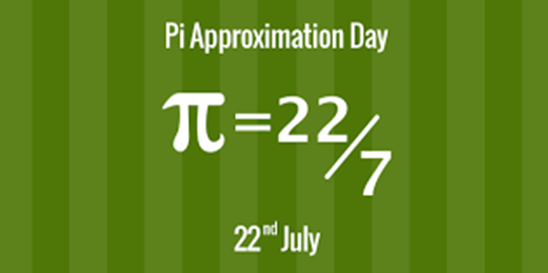Pi has also been related to spirituality. Pi points to infinity pointing towards the transcendence and imminence of spirit. It is also incorporated in our day to day life n the sense that everywhere there is a circle and Pi is also there. Pi Approximation Day (July 22) also called as the Pi Casual Day represents a day that glorifies the constant π (Pi); that in turn denotes the relationship between circumference of a circle and its diameter. This constant is somehow present in everyday life of all of ours.
Scientists at the National Aeronautics and Space Administration (NASA) keep their space station in operation with 15 or 16 digits of Pi. The Pi Approximation day is observed on July 22 (22/7 in the day/month format), since the fraction 22⁄7 is a common approximation of π, which is accurate to two decimal places. Succinctly, Pi which is written as the Greek letter for P or π is the ratio of the circumference of any circle to the diameter of that circle. Regardless of the circle’s size, this ratio will always equal Pi. In decimal form, the value of Pi is approximately 3.14. Since the mid-18th century Pi has also been represented by the Greek letter π.
In fact, the word ‘Pi’ itself was actually derived from the first letter of the Greek word perimetros, which means circumference. Pi is neither even nor odd. It is an irrational number means that its decimal form never ends (unlike ½=0.5). To only 18 decimal places value of pi is 3.141592653589793238. The digits of Pi continue their senseless procession all the way to infinity. Thus it was good to have a short form of Pi which was taken as 3.14, a universal value for the ratio of circumference to diameter.
History OF π:
The first calculation of π was done by Archimedes of Syracuse (287–212 BC), one of the greatest mathematicians of the ancient world. Peter Backmann in his book, ‘A History of Pi’ has written that the Greek letter was first used for this purpose by William Jones in 1706, probably as an abbreviation of periphery and became standard mathematical notation roughly 30 years later.
‘A History of Pi’ mentions that by 2000 BC, the Babylonians and the Egyptians were aware of the existence and significance of this constant. They had then recognized that every circle has the same ratio of circumference to diameter. Both of these civilizations had an idea of the rough numerical approximation of Pi.
At that time, an approximation of 3 times the square of the radius of the circle was used which returned a value of Pi as 3. The mathematicians from Egypt calculated Pi with an approximate value of 3.1605 as mentioned in Rhind Papyrus (1650 BC). Later on mathematicians in ancient Greece mainly Archimedes improved on these rough approximations and by the start of twentieth century, about 500 digits of this constant were known. He used a visually creative approach to approximate Pi by using the areas of two polygons.
Archimedes used this approach to estimate the area of the circle that could be drawn between two such polygons with one being just smaller than the other. From there he was able to approximate the value of pi between 22/7 and 24/7. Before the pi symbol was used, Pi was described as the quantity which, when the diameter is multiplied by it, yields the circumference. In the 1700s, the Swiss mathematician and Physicist Euler formalized the use of the Greek lowercase letter π as the notation for Pi. This is the first letter of the Greek word, perimetros, which translates as ‘circumference’.
Importance
Regarding the importance of Pi, it has been recognized since 4000 years ago. Pi finds most common and wide use in calculations regarding circles. Pi not only relates circumferences and diameter, it also connects the diameter or radius of a circle with the area of that circle. The formulae work out is that area is equal to pi times the radius squared. Besides, Pi unexpectedly often shows up in many mathematical equations.
In mathematics, this infinite number is crucial because of what it represents in relation to a circle it’s the constant ratio of a circle’s circumference to its diameter. Pi is also essential to engineering, making modern construction possible. It has helped us to understand the universe with much clarity. Its defination has inspired mathematicians and researchers all across the globe to have a new notion of the measurement of angles with a new unit of measurement that is universally applicable.
π and Spirituality
Pi has also been related to spirituality. Pi points to infinity pointing towards the transcendence and imminence of spirit. It is also incorporated in our day to day life n the sense that everywhere there is a circle and Pi is also there. The case of sun which makes the world move is also a circle, the spiral of DNA double helix, the pupil of our eyes, the concentric rings that travel outwards when we throw something in water bodies all are examples of importance of circle in our day to day life. Pi’s ubiquity goes beyond mathematics. The number crops up in natural world too.
π Approximation Day and π Day
Pi Approximation Day is different from Pi Day. Pi Day is celebrated on March 14 (written as 3-14 in the United States date format) as it is similar to the approximate value of 3.14. Pi Day, an annual celebration of the mathematical constant π (pi) is observed on March 14 (3/14 in the month/day format) since 3, 1, and 4 are the first three significant digits of π. It was founded in 1988 by Larry Shaw, an employee of the Exploratorium. Celebrations often involve eating pie or holding pi recitation competitions. In 2009, the United States House of Representatives supported the designation of Pi Day.
UNESCO‘s 40th General Conference designated Pi Day as the International Day of Mathematics in November 2019. Alternative dates for the holiday include July 22 (22/7, an approximation of π) and June 28 (6.28, an approximation of 2π or tau).
In recent years, some mathematicians and physicists have argued for the replacement of the π by 2π (tau) and to celebrate Tau Day on June 28 instead of celebrating Pi Day or Pi Approximation Day. The strive to discover more values of Pi for their more practical applications in different mathematical aspects has been a source of inspiration for many young scholars to go deeper into this constant. This day deserves to be celebrated.
(The author writes on agriculture and social issues, can be reached at [email protected])








